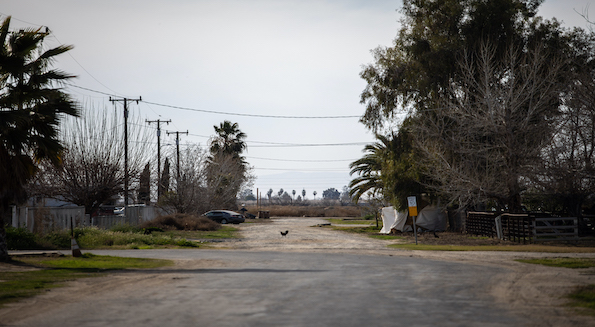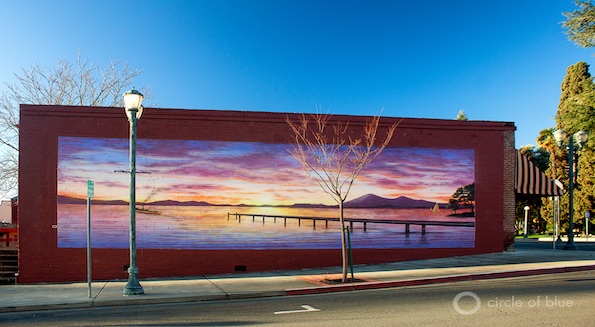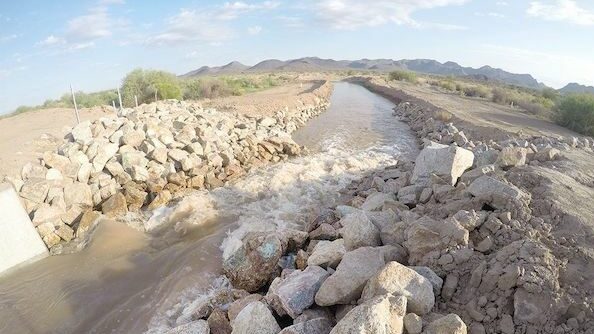Updates
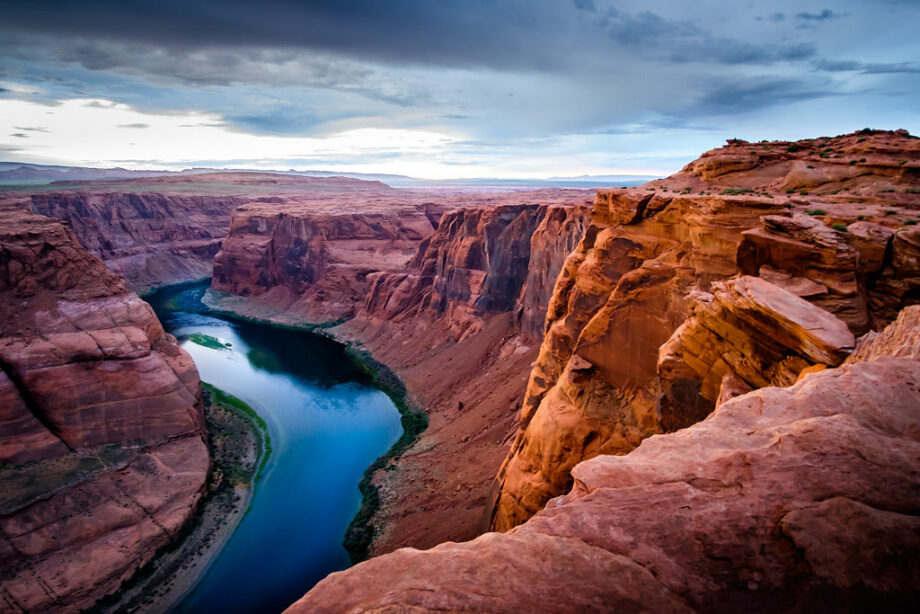
 Eight Institute for Nonprofit News newsrooms — California Health Report and High Country News; SJV Water and the Center for Collaborative Investigative Journalism; Circle of Blue; Columbia Insight; Ensia; and New Mexico In Depth — spent more than three months reporting on water issues in the Western U.S. The result — “Tapped Out: Power, justice and water in the West” — documents serious concerns including contamination, excessive groundwater pumping and environmental inequity — as well as solutions to the problems. It was made possible by a grant from The Water Desk, with support from Ensia and INN’s Amplify News Project. Click to read the stories below.
Eight Institute for Nonprofit News newsrooms — California Health Report and High Country News; SJV Water and the Center for Collaborative Investigative Journalism; Circle of Blue; Columbia Insight; Ensia; and New Mexico In Depth — spent more than three months reporting on water issues in the Western U.S. The result — “Tapped Out: Power, justice and water in the West” — documents serious concerns including contamination, excessive groundwater pumping and environmental inequity — as well as solutions to the problems. It was made possible by a grant from The Water Desk, with support from Ensia and INN’s Amplify News Project. Click to read the stories below.
California tribes call out degradation of Clear Lake
By Brett Walton, Circle of Blue
Seven years ago, after the fish died, Sarah Ryan decided she couldn’t wait any longer for help.
California at the time was in the depths of its worst drought in the last millennium and its ecosystems were gasping. For Ryan, the fish kill in Clear Lake, the state’s second largest and the centerpiece of Lake County, was the last straw.
Ryan is the environmental director for Big Valley Rancheria, a territory of the Big Valley Band of Pomo Indians that sits on the ancient lake’s western shore. She and others raised alarms for several years about increasingly dire blooms of toxic cyanobacteria. But Lake County officials and state agencies were not gathering the data on toxin levels that Ryan thought was necessary to adequately communicate the health risks to tribe members or to anyone else using Clear Lake to swim, fish, drink — or walk their dog.
Read more here >>
Some rural California residents doubt they’ll ever get clean water
By Claudia Boyd-Barrett, California Health Report and High Country News
When Ramona Hernandez turns on her kitchen faucet in El Adobe, an unincorporated town just a few miles southeast of Bakersfield, the water that splashes out looks clean and inviting. But she doesn’t dare drink it.
“You worry about your health,” she said in Spanish as she sat in her tranquil front yard one morning early this spring, her elderly mother-in-law working in the garden behind her.
“I’m scared,” Hernandez said, “of getting sick from the water.” Drinking the tap water in this tiny community of dusty ranches and unpaved roads could expose Hernandez to arsenic. So, for years, she and her husband, Gerardo, have shuttled twice a week to the nearby town of Lamont to load up on bottled water. At a cost of about $80 a month, it’s enough for drinking and cooking. If they had the money, Hernandez, 55, would buy bottled water to shower with and use for her chickens. But given her husband’s salary as a farmworker, she says, that’s not a realistic option.
Read more here >>
Toxic cyanobacteria choke water systems around California’s Clear Lake
By Brett Walton, Circle of Blue
On a good day, usually in late winter and early spring, the magnificent waters of Clear Lake seem to live up to their name. Under the shadow of the volcano Mount Konocti, the oldest lake in North America and second largest in California sparkles in an array of blues while fishing boats ply the shallow nearshore, their anglers hoping to hook a trophy bass.
From his office two miles inland, Frank Costner knows that the lake’s waters also shelter a treacherous occupant — potentially toxic blooms of cyanobacteria. As general manager of Konocti County Water District, Costner is responsible for supplying drinking water from Clear Lake to 4,500 people who live in this region a two-hour drive north of San Francisco.
Costner has worked at the district for 32 years and he knows when lake conditions deteriorate. Mats of cyanobacteria ring Clear Lake during warm months, covering its crystal waters along the shoreline with paint-like swirls of green and white. When the wind comes from the west, foul odors waft toward his office.
Read more here >>
Navajo-Gallup water delay spurs problem solving in arid Southwest
By Elizabeth Miller, New Mexico In Depth
Early this year, five of Gallup, New Mexico’s 16 water wells stopped producing water, including two of its biggest. After a few days of maintenance, two worked. The other three were out of commission for more than a month. Had it happened in summer, the city might have asked residents to dramatically reduce use.
“I’m not in crisis mode,” said Dennis Romero, Water and Sanitation Director for the City of Gallup, but “it could go to crisis mode very quickly.”
The shortage isn’t wholly surprising — 20 years ago, the city decided it could limp along on aging groundwater wells with dropping water levels until a new water project began delivering San Juan River water in late 2024. The project is also connecting nearby Navajo communities, where many residents lack running water, an issue the Navajo Nation says is long past due and in need of a fix. But now a potential four-year delay could force a growing number of people to rely on these strained groundwater sources. A plan to keep taps from running dry will come with a price tag.
Read more here >>
Cheese in the desert: Why mega-dairies are piping water onto Oregon’s shrub-steppe
By Dawn Stover, Columbia Insight
Cody Easterday is still waiting for the Oregon Department of Agriculture to approve his application, submitted in June 2019, for a Confined Animal Feeding Operation near the city of Boardman (pop. 3,340), 165 miles east of Portland. Easterday, a 49-year-old rancher whose family owns a huge agricultural operation in Washington state, proposes to open a mega-dairy that would be the second-largest in Oregon. The Easterday Dairy would have up to 28,300 animals and use more water than most cities in the state.
The future of Easterday Dairy is in doubt, however. On March 31, Cody Easterday pleaded guilty to a “ghost cattle scam” that defrauded Tyson Foods and another company out of more than $244 million by charging for the purchase and feeding of animals that never existed.
The following day, a coalition of activists testified at an Oregon Senate Committee on Energy and Environment public hearing, voicing support for a moratorium on new or expanded mega-dairies in the state. Many of them pointed to the Easterday Dairy proposal, as well as an earlier dairy cited for hundreds of environmental violations at the same location, as reasons to hit the pause button on dairies housing 2,500 animals or more.
Read more here >>
“A generational historic struggle to regain our water”
By Sharon Udasin, Ensia
A riverbed that has been parched since the end of the 19th century — a portion of the historic lifeblood of the Gila River Indian Community — is now coursing again with water, luring things like cattails and birds back to its shores.
“You add water and stuff just immediately starts coming back naturally. Birds have returned and it’s just such a different experience,” says Jason Hauter, an attorney and a Community member. “It’s amazing how much has returned.”
The revival of this small segment of the 649-mile (1045-kilometer) Gila River, which has served the tribes that make up the Gila River Indian Community — the Akimel O’odham (Pima) and the Pee-Posh (Maricopa) — for roughly 2,000 years, was an added benefit of a grassroots infrastructure overhaul, known as “managed aquifer recharge,” or MAR, which aimed to restore the local groundwater basin. The MAR project has not only secured a water supply for local agriculture, but it has also generated a stable source of income and strengthened the Community’s ties to tradition.
Read more here >>
— May 14, 2021

Back in 2012, our team asked, “What if we launched a bold new site where stories focused on solutions to our biggest environmental challenges rather than only on doom-and-gloom reporting?”
From that question Ensia.com was born, and we went live to the world six years ago today!
Since then we’ve published hundreds of original feature stories, articles, commentaries and multimedia pieces. We’ve cultivated a network of more than 50 leading global media partners — including The Guardian, Business Insider, Scientific American, Public Radio International, Vox and Quartz — that republish Ensia’s content, increasing our reach and impact. Some of those partners have even translated our stories into more than a dozen languages, furthering our reach even more.
All told, Ensia stories influence millions of people annually and have been promoted by thought leaders across sectors, shared during legislative briefings, included in college courses and cited in publications around the world.
None of this would be possible without you — our readers.
As we celebrate our sixth anniversary, we thought it would be fun to look back at the six most-read stories at Ensia.com since we launched:
6) In this opinion piece from 2013, global environmental scientist Jon Foley argues the dominant story about the future of the world food supply is logical, well known and wrong.
5) CRISPR has gotten a lot of attention lately, but back in 2016 our fifth most-read story by food systems researcher Maywa Montenegro was one of the first articles to dive deep into the technology’s potential impact on the environment.
4) “Roads? Where we’re going we don’t need … roads.” Our fourth most-read piece kicks off with a quote from the 1985 classic Back to the Future as it looks to the future of sustainability.
3) Author and photojournalist Michael Kodas takes readers on a tour of the tropics as he explores the burning question, “How did palm oil become such a global problem?”
2) In our second most-read feature, the late, great Elizabeth Grossman (who we still miss) asks why are some chemicals banned in the EU but not the U.S.? (You can read Lizzie’s many stories for Ensia here.)
1) Published in partnership with the Food & Environment Reporting Network, our most-read story of all-time is by journalist Elizabeth Royte, who explores the role urban farming will — or won’t — play in ensuring global food security.
Bonus: Our most-viewed video of all-time merges 132 years of global average temperatures with notes on a cello to create a haunting composition that traces the warming of our planet year by year since the late 19th century.
As we look ahead, we’re excited about what’s next!
We recently launched a new initiative — Ensia Answers — that allows readers like you to suggest and vote on future content.
And we have new series and partnerships in the works, exploring our most pressing environmental challenges.
Finally, as a nonprofit, we rely on the support of our readers to publish award-winning journalism, so if you’d like to help propel Ensia into the future, please consider donating today.
On behalf of our entire team, thank you for an incredible six years. Here’s to the next six and beyond! — February 5, 2019
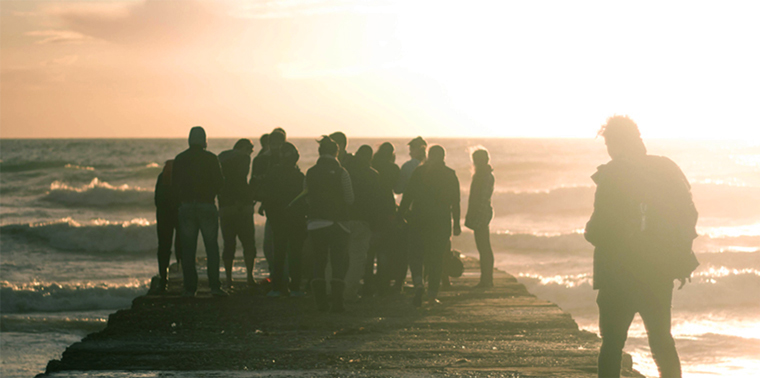
As I look back on 2017, one thing is clear: Media and science are facing an attack unlike anything I’ve seen in my lifetime.
At Ensia, we pride ourselves on being a nonpartisan publication, or, as we often say, “beyond politics” in our approach to the issues we cover — because we know that these issues are everyone’s issues. They may not affect everyone equally, but they do affect everyone.
But we are living in extraordinary times.
 Climate change is harming our world and us in real time. Wild plants and animals are being lost in record numbers. And many of our foundational beliefs (for example, the right to clean air and clean water) and institutions (for example, the U.S. Environmental Protection Agency) seem like they are up for grabs.
Climate change is harming our world and us in real time. Wild plants and animals are being lost in record numbers. And many of our foundational beliefs (for example, the right to clean air and clean water) and institutions (for example, the U.S. Environmental Protection Agency) seem like they are up for grabs.
In the face of all this, we believe people like you — all over the world — deserve the information needed to improve public discourse, make more informed decisions and fight for a better future.
Because the future doesn’t just happen. We create the future.
And that’s why we need your support. And we need it now — so we can continue publishing stories that adhere to the highest standards in journalism ethics, and, more broadly, help create the brighter future we believe is possible: A future in which truth and accuracy matter; in which shared stories about people working hard to solve our biggest environmental challenges inspire others to do the same; in which we remain steadfast in our hope and knowledge that humans can live in harmony with a healthy environment.
Your tax-deductible donation — which is being doubled now through Dec. 31 thanks to News Match — not only helps us financially, but also is a vote of support for all these things we believe to be true.
In return, we promise to work even harder to shine a light on solutions to environmental challenges and help change-makers like you lead the way to a better future. ![]()
SaveSave — December 21, 2017

We want to hear from you, our readers. Please take a moment to vote on which of the four stories below from the past year left the biggest mark on you. We’ll let you know the winner in a few days.
[yop_poll id=”2″]
If you need a refresher, you can revisit these stories on hazardous vapors, carbon sequestration, wildlife ranching and deep ocean impacts.
Ensia is committed to publishing in-depth, impactful pieces showcasing innovative responses to global environmental challenges across a broad range of topics. Your input today will help ensure that we continue to tell the stories you believe need to be told.
And as always, we welcome your feedback and suggestions for topics we should cover in the coming months and beyond. — November 10, 2017
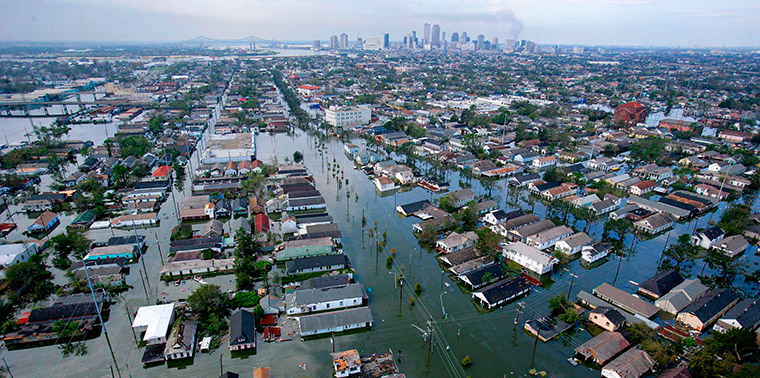
Today we’re proud to announce the launch of Ensia Edge, a new multimedia storytelling platform, with a story by veteran journalist Peter Dykstra. “Forewarned” focuses on dogged reporters and media outlets that shine a light on looming environmental disasters — often years in advance of these issues garnering mainstream recognition — and explains why it behooves us to listen to such reporting while we still have time to do something about it.
As the piece explains, “both environmental reporting and the science that backs it up are now old enough to have a history — and that history is overwhelmingly strong. When published warnings get ignored, the damages can often be measured in destroyed ecosystems, lost lives, impaired health and billions of dollars of costs. Which means that paying attention to the warnings we receive today could make a big difference tomorrow.”
Edge offers us the opportunity to tell important, media-rich stories on an immersive platform that brings the stories to life in a new way. We invite you to explore “Forewarned” and let us know what you think, both of the story and of the Edge platform.
We also invite you to share your own suggestions for environmental reporting we should heed using the hashtag #FOREWARNED and tagging @ensiamedia on social media. Shining a light on stories that affect people’s lives in such dramatic ways is more important now than ever. ![]() — February 24, 2017
— February 24, 2017

Do you think the world needs more high-quality, trustworthy environmental reporting? Stories that bridge partisan divides and move beyond problems to explore solutions? And guidance for tomorrow’s environmental communicators?
If you answered yes to these questions, then we need your help today!
Your tax-deductible contribution to Ensia supports coverage of important and often underreported topics, allows us to share our solutions-focused stories with other media outlets — and millions of readers — around the world, and helps build a bright future for environmental journalism through our signature mentor program.
Here’s a sample of what past donors have gotten in return for their investment in Ensia:
- The writer of an Ensia story on how federal crop insurance can negatively impact sustainable agriculture was invited to speak to U.S. Senate staffers working on the 2017 Farm Bill.
- Our piece on desalination as a pathway to peace in the Middle East was republished by Scientific American and dozens of other outlets, reaching nearly 500,000 readers, and sparked an op-ed in a major publication in India calling for similar efforts there.
- Ensia was one of the first publications to explore how CRISPR technology could revolutionize global food production — with a commentary that is now being used as background reading in college classes around the United States.
If you think we could use more of this type of high-quality, in-depth journalism in 2017, then please show your support today.
As a special gift to those who donate at least $100 by Dec. 31, 2016, we’ll send a limited-edition copy of our beautiful new “Best of the Year | Year Ahead” print issue.
Thank you! — December 22, 2016
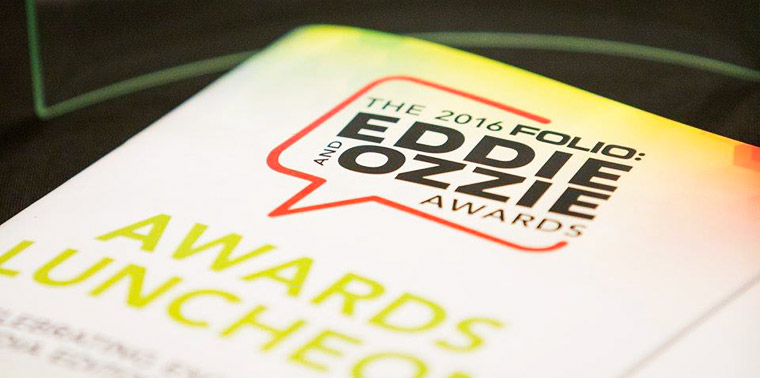
Ensia’s “Best of the Year 2016” print issue received an honorable mention at the 2016 Eddie and Ozzie Awards held recently in New York City. Scientific American took home top honors in the category in which Ensia was competing.
The Eddie and Ozzie Awards recognize excellence in magazine editorial and design. A panel of nearly 300 judges reviewed over 2,800 entries to select the winners and honorable mentions, and the awards luncheon was attended by top magazine executives from across the United States. This is the second time Ensia has been recognized by Folio: — the sponsor of the Eddie and Ozzie Awards — for editorial excellence. The previous award was received in 2014. ![]() — December 16, 2016
— December 16, 2016

Whatever your feelings on the outcome of last week’s U.S. presidential election, this is a momentous time in America and around the world.
Some of our readers may be feeling excited about the future, while others are anxious about what comes next. As Ensia’s publisher, I want to share a few thoughts on what the election means for our magazine.
First, let me emphasize that Ensia is, and always has been, inherently apolitical. We believe that environmental issues are everyone’s issues, regardless of political persuasion or affiliation, and we strive to provide high-quality journalism without favoring a liberal or conservative perspective. We believe that the right way to report on environmental challenges is with an eye to solutions. And we believe that solutions can come from all directions — with the very best tending to emerge where diverse perspectives come together in pursuit of common goals.
Second, it is important to remember that although the U.S. federal government is a powerful force, it is far from the only force shaping our future. A big role for Ensia in the months ahead is to ramp up our efforts to engage and inform the many other movers and shakers that are in a position to step up to the plate: corporations, non-governmental organizations, other nations and other levels of government within the U.S.
Now more than ever, we need to commit ourselves to producing high-quality, independent journalism. Now more than ever, we need to ensure that fact-based, solutions-focused reporting reaches beyond those who are self-motivated to seek out environment-related news.
Ensia’s mission is to share stories and ignite conversations that motivate and empower people — all people — to create a more sustainable future. The 2016 presidential election has not changed that. What it has done is remind us of the diversity of perspectives the people we strive to serve bring to the conversation. It has underscored the importance of Ensia’s unique approach to environmental journalism. And it has inspired us to double down on our efforts to provide the best in environmental journalism to leaders of all kinds across geographies and ideologies as we strive together to shape a world future generations can live with.
If you agree this is what’s needed in these changing times, we welcome you to support our work. ![]() — November 16, 2016
— November 16, 2016
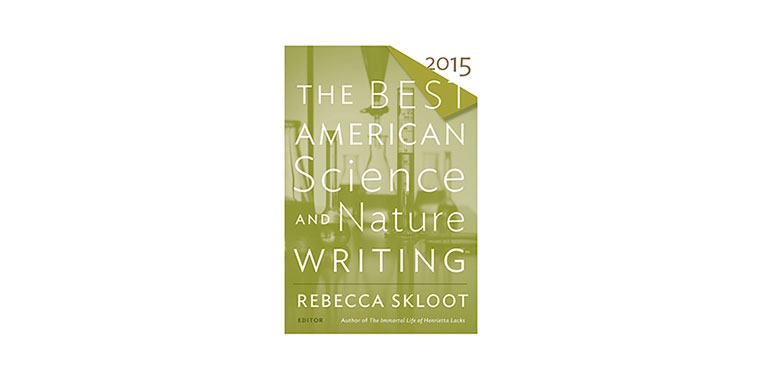
Congratulations to environmental journalists Elizabeth Grossman, Phil McKenna and Edward Struzik for writing Ensia feature stories that received a “Notable” mention in the 2015 edition of The Best American Science and Nature Writing.
Grossman was included in the book’s “Other Notable Science and Nature Writing of 2014” section for “Banned in Europe, safe in the US,” which explores why different countries regulate chemicals differently. The feature story has been viewed online more than 350,000 times and helped launch Ensia’s popular Health content category.
McKenna’s feature, “New life for the artificial leaf,” describes the quest for technologies that look to plants for clues on how to efficiently capture the sun’s energy. In addition to garnering substantial attention at Ensia, the piece was republished by several outlets, including the popular online news outlet Quartz.
“The end and beginning of the Arctic,” which won Struzik recognition, brings together diverse reports of climate-induced changes at the top of the world into a single, comprehensive exploration of important environmental and political implications. The piece was also featured in Ensia’s 2016 print annual.
The three ranked with pieces published in The New Yorker, Scientific American, National Geographic and other widely acclaimed periodicals. Ensia is proud to share the work of these exceptional contributors and to encourage and support excellence in science writing. ![]()
— December 2, 2015
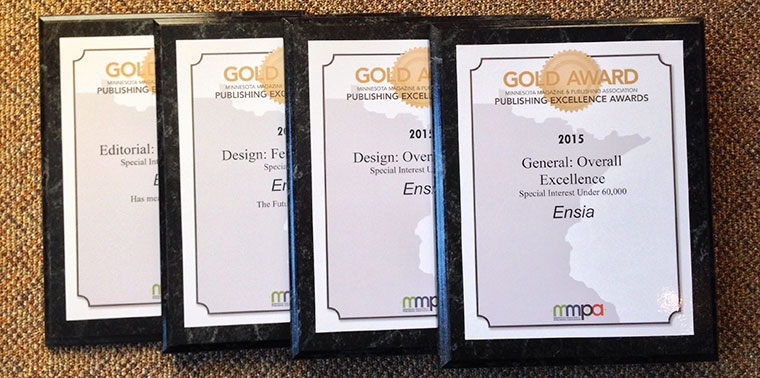
Ensia received four Gold awards, a Silver and a Bronze at last night’s Minnesota Magazine Publishing Excellence Awards ceremony in Minneapolis. The awards — presented by the Minnesota Magazine & Publishing Association — recognize outstanding publishing achievements in the areas of editorial, design, marketing, digital publishing and overall excellence.
The winning entries included gold awards for overall excellence, overall design, feature design and feature writing for the story “Has meat met its match” by Rowan Jacobsen. The story “The beginning and end of the Artic” by Edward Struzik took home a silver for feature writing, and the design team received a bronze for spread design. — November 13, 2015

As 2014 comes to a close and we prepare to celebrate Ensia’s second anniversary this coming February, I wanted to take a moment to reflect on the journey we’ve been on over these past couple of years.
In my role as Ensia’s director, I often meet with potential partners, supporters, thought leaders and others. More often than not, one of the first questions I’m asked is, “How big is your audience?”
Thanks to Ensia’s steady growth and increasing number of republishing partners, millions of people now view our content globally. While that’s important and something we’re committed to expanding, I’m much more interested in another question that may or may not be tied to the size of the audience: “What’s your impact?”
Which begs another question: How do we accurately measure impact across a changing media landscape? Clicks? Comments? Unique visitors? Social media followers?
Those all are important, but what I really want to know is, did we make a difference in the world?
Did any business leaders reassess their supply chain after reading about the emerging zero waste world or recycling opportunities for rare earth metals? Did utility managers question the price of water in their community after seeing our story on this undervalued resource? Did investors look to green bonds to boost their bottom line and benefit the environment? Did consumers change their shopping habits because of our stories on palm oil, the future of meat or food packaging? Did someone donate to a conservation organization in hopes of stemming the illegal wildlife trade after reading our interviews with Peter Knights of WildAid or Iris Ho with Humane Society International? Was a new partnership formed or conversation started after reading a compelling Voices commentary?
We’ve heard stories of these actions starting to take place, and that gives us hope that we’re on the right track. For example, we were able to connect a palm oil plantation manager in Colombia with researchers in Colorado who reported on fixing issues around methane emissions from palm oil plantations. The Canadian chapter of the Wildlife Conservation Society approached author Ed Struzik to deliver the keynote speech at its annual conference after reading his feature story on the changing Arctic. And commentaries such as the one we published on GMOs have led to a rich online discussion among people on both sides of the issues.
Sure, I could tell you about page views, unique visitors and media partners — all of which are important to our success. But at Ensia and at the Institute on the Environment, our home institution, making a difference in the world is what inspires our work. What it boils down to is this: One unique visitor is enough — if it’s the right visitor, and that visitor is inspired or empowered by a story to change the world.
As I wrote earlier this year, it only takes a moment or a simple statement to transform someone’s life — and improve the environment we all depend on.
In 2015 we’ll continue to publish high-quality, trusted journalism. We’ll also continue to look for underreported stories, ask provocative questions and shine a light on innovative solutions — all while exploring new ways to measure and track impact.
Our goal is to challenge you to think differently while offering a sense of hope. As you think back over this past year, we hope you recall a time when an Ensia story opened the door to a new insight or led you to take action on an issue. If so, we’d love to hear from you via email, Facebook or Twitter.
The challenges facing the world today are daunting, but what if we focused more on the people, places and projects working toward solutions and a more positive future? At this point we don’t have the luxury of sitting back and complaining. It’s time to get to work and have an impact. ![]()
Todd Reubold | Ensia director and founding editor
Photo by Thomas Leuthard (Creative Commons | Flickr) — December 31, 2014

Want to use your career to have a positive impact on the world? Take the first step by joining Ensia in Minneapolis this November 6- 8 for the annual Net Impact Conference. This year’s event will bring together 2,700 business and sustainability leaders from around the world. Conference attendees can choose from 100 interactive sessions in tracks ranging from environment and natural resources, sustainable food and agriculture, and corporate impact and career and professional development. Participants will also have ample time for networking and exploring the Twin Cities — Ensia’s hometown and one of the most beautiful and progressive cities in America. Register now — October 15, 2014

Ensia is excited to be a supporter of SXSW Eco taking place in Austin, Texas October 6–8. The first round of sessions was just announced and the topics range from biomimicy and smart grids to future cities and a Fitbit to save elephants. Featured speakers include author Christine Bader and environmental justice legend Robert Bullard — both interviewed recently by Ensia. And new this year, the exhibit and panel series Cleantech Global will “showcase the world’s most forward-thinking cities, places where sustainability and clean energy form the backbone of urban planning and economic development.” Register for SXSW Eco today and we’ll see you in Texas this fall! Photo by Ed Schipul (Creative Commons | Flickr) — June 27, 2014
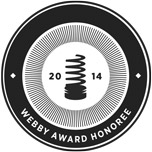
Ensia has been named an honoree in the Best Green Website category of the 18th Annual Webby Awards. Hailed as the “Internet’s highest honor” by the New York Times, the Webby Awards, presented by the International Academy of Digital Arts and Sciences, are the leading international awards recognizing excellence on the Internet. This year nearly 12,000 entries were received from all 50 U.S. states and over 60 countries worldwide. — April 9, 2014

When we launched Ensia magazine online and in print a year ago this week, we didn’t know exactly what to expect. Would there be an interest in hopeful, solutions-oriented stories in a world filled with environmental doom and gloom? Was there room for thoughtful, original articles and commentaries amidst the flood of click-bait headlines and cotton candy content?
You responded with a resounding “Yes!” and for that we want to say, “Thanks!”
In Ensia’s first year, hundreds of thousands of you from more than 160 countries around the world read our stories, viewed our multimedia and shared our content via social media. Perhaps most important of all, though, you engaged with one another through thoughtful comments and discussions on ensia.com, Twitter, Facebook and elsewhere. If we’ve started to play even a small role in sparking conversations that lead to solutions to our biggest environmental challenges, the late hours and caffeine-fueled editorial deadlines will be worth the effort.
Along the way, we’ve learned quite a bit. And you’ve helped keep us on our toes, too.
We were surprised by the stories that resonated with you: Who knew an article on climate change cuisine would be one of our most popular?
Your views and shares showed us there’s still a place in the world for in-depth reporting on important issues such as a new path for conservation, nature-inspired urban design, the need to reduce groundwater depletion and solar energy solutions for the developing world. Regarding that last piece, the head of a renewable energy company in India commented, “This is the primer that I’ll send to anyone who wants to understand the landscape for clean energy in developing countries.” Feedback like this really tells us we’re on to something.
We were pleasantly surprised by your overwhelming response to the Voices commentaries we invited from some of today’s most influential environmental leaders and writers. We initially planned on a dozen of these essays throughout the year, but in the end we published more than 50. Pieces on changing the global food narrative, the link between pregnancy advice and climate change, how cultural norms play into natural disasters and the death of sustainability were among our most popular throughout the year.
The response to the Ensia Mentor Program for emerging environmental communicators has also been tremendous. Stories by our mentees on mock lion hunts and the importance of funding long-term ecological research show that the future is in good hands as long as opportunities for thoughtful environmental coverage exist.
Something we never expected was to be called upon frequently throughout the year as an advisor. Yet over the past year, we’ve been contacted by media and environmental organizations based in the U.S. and the U.K. looking to expand their focus on “solutions journalism.”
Through email and in person, you also told us that you appreciate Ensia’s commitment to both solid content and smart design. We try to appeal to both the head and the heart, the left and the right brain, and our efforts to do so appear to be paying off.
Ensia was also fortunate to receive a number of professional accolades this past year, including an Eddie editorial award from Folio magazine and a Judge’s Choice Award during AIGA’s (Re)design competition. We were particularly pleased with the comment from one of the AIGA judges, who noted, “By filling the vast void left by the corporate-owned media outlets for environmental reporting, Ensia highlights the myriad of environmental issues and solutions that are happening today… The design itself is clean, functional in modern media, and highly visual when other magazines and websites are text heavy.”
Of course, it hasn’t exactly been a cakewalk. We learned that publishing original, edited and diligently fact-checked content five times a week requires a lot of early mornings and late nights. We also learned that finding funding for an independent nonprofit magazine is a near full-time job — which makes us more thankful than ever for the support we’ve received from the University of Minnesota’s Institute on the Environment, the Gordon and Betty Moore Foundation and private individuals who’ve stepped forward to help us grow Ensia. If you’re interested in contributing to future environmental reporting or helping us train the next generation of environmental communicators through the Ensia Mentor Program, we’d sure appreciate your support.
Ensia hosted several large, public events during the spring of 2013. We’re now assessing new opportunities in the events space. We strongly believe in the power of targeted, in-person interactions to move the conversation toward environmental solutions, so stay tuned for details in the year ahead.
As we strive to magnify Ensia’s reach and impact, developing meaningful, lasting partnerships with both nonprofit and for-profit media outlets remains a work in progress. We’ve started several exciting new media partnerships during the past year (with a few more high-profile connections to be announced in the months ahead), but reaching out beyond the “choir” to attract new audiences is a constant part of our day-to-day activities — and one of the most important things we can do if we’re really going to move the needle on these issues.
In closing, we’d love to hear from you. What are we doing right? How can we improve? What environmental issues do you think deserve to be in the spotlight over the coming year? You can engage with Ensia on Twitter or Facebook, or if you prefer, send me a message via email.
On behalf of everyone at Ensia, thank you once again for your support throughout our first year! We look forward to bringing you more stories of inspiring solutions to environmental challenges in the months and years to come.
Todd Reubold | Ensia director and founding editor
Photo by Omer Wazir (Creative Commons | Flickr) — February 4, 2014

Ensia has been nominated for a 2013 Katerva Award in the Behavioral Change category. Launched in 2011, the international Katerva Awards honor the most promising sustainability innovations. Nominees are determined by the Global Action Network — a community of 400 subject matter experts around the world. Winners will be announced in February. — January 14, 2014

As we near the end of Ensia’s first year, we hope you have found the solutions-focused stories, op-eds, infographics, videos and photo galleries illuminating, and that they have helped spark conversations and new ways of thinking about the biggest environmental issues we face today. While there are many great ways to stay in touch with Ensia, our weekly e-newsletter might be the easiest. Delivered every Thursday, the newsletter highlights the week’s top stories, ensuring that you never miss a thing. If you’re not already a subscriber, sign up. Bonus: It will only take you about 10 seconds.
Thank you for reading and supporting Ensia in 2013. We look forward to an even better year in 2014.
Photo by CeresB (Creative Commons | Flickr) — December 30, 2013

AIGA, one of the world’s largest professional organization’s for design, last night recognized Ensia with a Judge’s Choice Award in the 2013 (Re)design awards competition. The international competition “recognizes design that challenges us to (re)think the world and our choices” and is based on the philosophy that “through masterful storytelling, compelling visuals, and beautiful design, we have the power to shape the future and ignite change.” Other 2013 award recipients include projects done for Human Rights Campaign, The Bill & Melinda Gates Foundation, the Children’s National Medical Center, Earthjustice and more. — October 11, 2013

Do you have a solutions-focused environmental story you’d like to share with Ensia’s global community? The Ensia Mentor Program offers aspiring environmental communicators a chance to contribute by creating an article, video, image gallery, infographic or other work under the guidance of an experienced professional. We welcome students, scientists and others with a story to tell — and an interest in having a mentor help them tell it well — to apply. Both mentors and mentees receive a stipend. — August 21, 2013

Ensia has been named a finalist in the 2013 AIGA (Re)Design Awards competition. The awards “celebrate the most influential designs that advocate for strong communities, sustainable environments and thriving economies while challenging us to (re)think the world and our choices..” Winners will be announced October 10. — August 6, 2013

What do conservation biologist M. Sanjayan, supermodel Amber Valletta and Reverend Lennox Yearwood Jr. have in common? They’ll all be converging in Austin, Texas, this fall for the third annual SXSW Eco. Once again, Ensia will be in attendance as an official supporter.
What should conference attendees expect? In true Austin fashion, a little bit of everything — with sessions running the gamut from reducing food waste in the U.S. to sustainable travel and future-proofing cities. (Personally, we’re really intrigued by the session titled “Creating an Irresistible Future” — who wouldn’t want that?)
In addition to three days of engaging breakout sessions and panel discussions, SXSW Eco will also feature a public space design competition, film screenings, a Big Data hackathon and the ever-popular Startup Showcase. Last year’s showcase winner — PlanetReuse, an online marketplace facilitating building material reuse nationwide — hit its Series A funding goals less than a month after the victory at SXSW Eco, so you know this is the place to see the technologies of tomorrow before they hit the big time.
SXSW Eco takes place October 7–9, 2013, in Austin, Texas. For discount tickets, enter the code “reg-eco-sec_j49vlsdkjv” on the registration page.
Photo by eschipul (Flickr | Creative Commons) — July 18, 2013
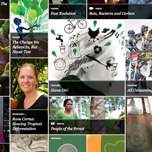
Communication Arts recently named Ensia the WEBPICK OF THE WEEK and commented, “With its clean, modern and responsive design the site stands out from its peers in the environmental news space.” We’re truly honored by this high praise coming from one of the standard bearers in the visual communications space. — May 3, 2013

As 60 million people move into cities each year in developing countries, Peter Williams will show why our planet’s rapid urbanization requires us to think in an entirely new way about design, development and disease. Using stunning visuals and personal stories, Williams will take the audience on a tour of the globe from Nigeria to India, Cameroon to Jamaica — and points in between — as he explores this 21st century challenge in a way that refuses to consider living conditions and human health separately, arguing instead for a systemic approach if we are to truly address these issues unique to our time. Get your tickets today. — March 29, 2013

Ready to be inspired? Buy your tickets now for Ensia Live, featuring futurist Jamais Cascio, sustainability expert Peggy Liu and global architect Peter Williams along with performances by Ribnic Circus, Twin Cities Women’s Choir and artist Gregory Euclide with percussionist S. Carey. — March 8, 2013

We couldn’t be more pleased to announce that the Institute on the Environment’s award-winning Momentum web, print and event platform has received a generous grant from the Gordon and Betty Moore Foundation to dramatically expand our content and reach. Along with the new growth comes a new name—Ensia—and reaffirmed mission: to connect people who can change the world with the ideas, information and inspiration they need to do so. Big thanks to the Moore Foundation for the funding and vote of confidence! — January 8, 2013

